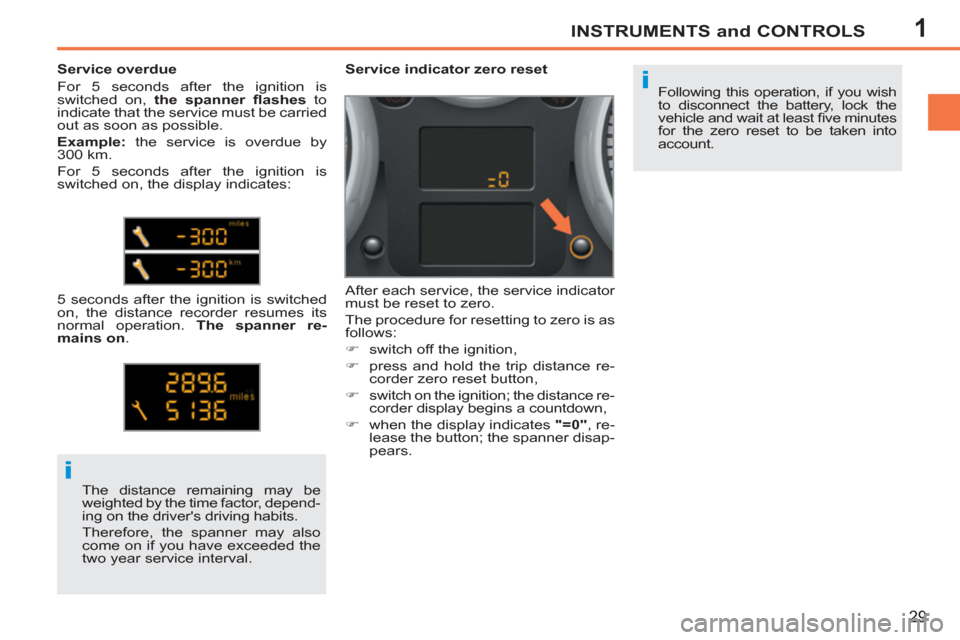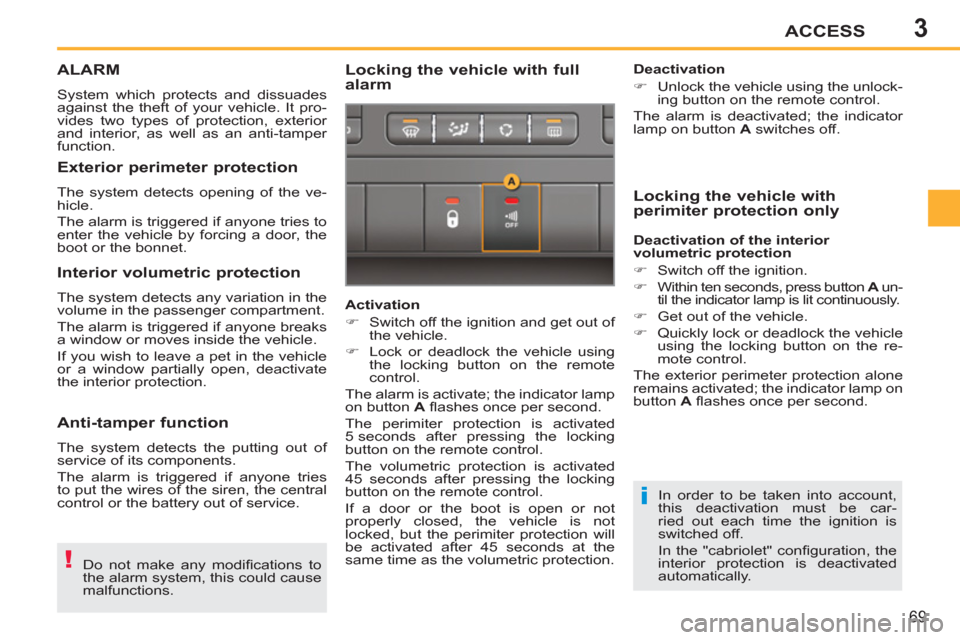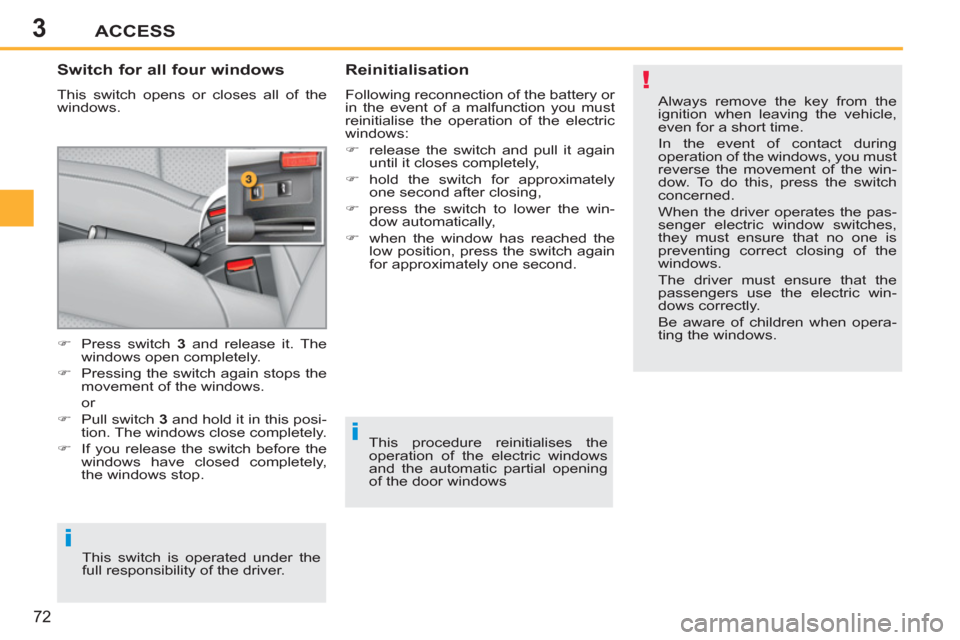2012 Peugeot 207 CC battery
[x] Cancel search: batteryPage 5 of 224

3
CONTENTS
Direction indicators 93
Emergency or assistance
call 93
Hazard warning lamps 94
Horn 94
Tyre under-infl ation detection 95
Braking assistance
systems 96
Trajectory control
systems 97
Seat belts 98
Airbags 101■
■
■
■
■
■
■
■
■
SAFETY 93 �Π104
Parking brake 105
Manual gearbox 105
Gear shift indicator 106
Automatic gearbox 107
Speed limiter 110
Cruise control 112
Parking sensors 114■
■
■
■
■
■
■
DRIVING 105 �Π11 5
Bonnet 117
Running out of fuel (Diesel) 117
Petrol engines 118
Diesel engine 119
Checking levels 120
Checks 121■
■
■
■
■
■
CHECKS
116 �Π122
Temporary puncture
repair kit 123
Changing a wheel 128
Changing a bulb 132
Changing a fuse 136
Battery 141
Energy economy mode 143
Changing a wiper blade 143
Towing the vehicle 144
Towing a trailer 145
Accessories 147■
■
■
■
■
■
■
■
■
■
PRACTICAL
INFORMATION 123 �Π147
Petrol engines 148
Weights (petrol) 149
Diesel engine 150
Weights (Diesel) 151
Dimensions 152
Identifi cation markings 153■
■
■
■
■
■
TECHNICAL
D ATA 148 �Π154
AUDIO EQUIPMENT
and TELEMATICS 155 �Π210
Emergency or assistance 155Peugeot Connect Navigation (RNEG) 157
Peugeot Connect Sound (RD5) 189■
■
■
ALPHABETICAL
INDEX 215 �Π218
7
86
9
10
VISUAL
SEARCH 211 �Π214
Page 8 of 224

! !
i
6
FAMILIARISATION
OPENING
Retractable roof
When washing your vehicle:
- lock the vehicle,
- avoid spraying the upper part
of the windows,
- keep the end of the high-pres-
sure nozzle at least 1 metre
from the windows and door
seals.
After washing the vehicle or fol-
lowing rain, wait until the roof has
dried before opening it. The roof is operated under the
sole responsibility of the driver.
During operation of the roof, to
avoid the risk of injury, ensure
that no one is in the vicinity of the
moving parts.
You are strongly advised not to
operate the roof in strong winds. It is preferable to operate the roof
with the engine running.
The roof can be operated at
speeds below 6 mph (10 km/h).
It is only possible to carry out the
operation twice with the engine off,
to prevent discharging of the bat-
tery.
Preliminary conditions
�)
Switch on the ignition.
�)
Ensure that:
- the vehicle is not in energy econo-
my mode (refer to the correspond-
ing section),
- the battery voltage is suffi cient
(switching on of the indicator lamp
on the roof control),
- the roof fuse is in good condition (re-
fer to the corresponding section),
- the electric windows are initialised
(refer to the corresponding section),
- the ambient temperature is above
-15 °C.
Precautions to be taken before
operating the roof
�)
Park the vehicle on level ground.
�)
Check that no object could hinder
the operation of the roof:
- nothing should be placed on the
moving rear shelf 1
or on the net 2
,
- if luggage is being carried in the
boot, it must not raise the net,
�)
Ensure that the net 2
is secure.
�)
Close the boot correctly.
Maintenance
Carry out a complete roof opera-
tion at least once a month to keep
it in good working order.
Page 26 of 224

1
!
INSTRUMENTS and CONTROLS
24
Warning lamps
When the engine is running or the vehicle is
being driven, the illumination of one of the fol-
lowing warning lamps indicates a fault which
requires action on the part of the driver. Any fault resulting in the illumination of a warning lamp must be investigated
further by reading the associated message in the multifunction screen.
If you encounter any problems, do not hesitate to contact a PEUGEOT dealer
or a qualifi ed workshop.
Warning lamp
is on
Cause
Action/Observations
STOP
fi xed, alone or
associated with
another warning lamp,
accompanied by an
audible signal and a
message on the screen.
Illumination of the warning
lamp is associated with a
serious braking system or
engine coolant temperature
problem. Stop as soon as it is safe to do so as the engine
may cut out when driving.
Park, switch off the ignition and call a PEUGEOT
dealer or a qualifi ed workshop.
Service
temporarily. Minor problems have
occurred for which there is
no specifi c warning lamp. Identify the problem by reading the message
shown in the screen, such as, for example:
- the engine oil level,
- the screenwash level,
- the remote control battery,
-
saturation of the particle emission fi lter on Diesel
vehicles (see "Checks - § particle emissions fi lter").
For any other faults, contact a PEUGEOT dealer
or a qualifi ed workshop.
fi xed. Major problems have
occurred for which there is
no specifi c warning lamp. Identify the problem by reading the message
shown in the screen and contact a PEUGEOT
dealer or a qualifi ed workshop.
Braking
fi xed, associated
with the STOP
warning lamp. The braking system fl uid
level is too low. You must stop as soon as it is safe to do so. Top
up with brake fl uid recommended by PEUGEOT.
If the problem persists, have the system checked
by a PEUGEOT dealer or a qualifi ed workshop.
+
fi xed, associated
with the STOP and
ABS warning lamp. The electronic brake force
distribution (EBFD) system
has a fault. You must stop as soon as it is safe to do so.
Have it checked by a PEUGEOT or a qualifi ed
workshop.
Page 28 of 224

1INSTRUMENTS and CONTROLS
26
Warning lamp
is on
Cause
Action/Observations
Maximum
coolant
temperature
fi xed red. The temperature of the
cooling system is too high. Stop as soon as it is safe to do so.
Wait until the engine has cooled down before
topping up the level, if necessary.
If the problem persists, contact a PEUGEOT
dealer or qualifi ed workshop.
Engine oil
pressure
fi xed. There is a fault with the
engine lubrication system. You must stop as soon it is safe to do so.
Park, switch off the ignition and contact a
PEUGEOT dealer or a qualifi ed workshop.
Battery
charge
*
fi xed. The battery charging circuit
has a fault (dirty or loose
terminals, slack or cut
alternator belt, ...). The warning lamp should go off when the engine
is started.
If it does not go off, contact a PEUGEOT dealer
or a qualifi ed workshop.
Door(s)
open
fi xed if the
speed is
below 6 mph
(10 km/h).
A door, the boot or the rear
screen is still open. Close the door or boot.
fi xed and
accompanied
by an audible
signal if the
speed is
above 6 mph
(10 km/h).
*
According to destination country.
Page 31 of 224

1
i
i
INSTRUMENTS and CONTROLS
29
Following this operation, if you wish
to disconnect the battery, lock the
vehicle and wait at least fi ve minutes
for the zero reset to be taken into
account.
Service indicator zero reset
After each service, the service indicator
must be reset to zero.
The procedure for resetting to zero is as
follows:
�)
switch off the ignition,
�)
press and hold the trip distance re-
corder zero reset button,
�)
switch on the ignition; the distance re-
corder display begins a countdown,
�)
when the display indicates "=0"
, re-
lease the button; the spanner disap-
pears.
The distance remaining may be
weighted by the time factor, depend-
ing on the driver's driving habits.
Therefore, the spanner may also
come on if you have exceeded the
two year service interval.
Service overdue
For 5 seconds after the ignition is
switched on, the spanner fl ashes
to
indicate that the service must be carried
out as soon as possible.
Example:
the service is overdue by
300 km.
For 5 seconds after the ignition is
switched on, the display indicates:
5 seconds after the ignition is switched
on, the distance recorder resumes its
normal operation. The spanner re-
mains
on
.
Page 69 of 224

3
i
ACCESS
67
Starting the vehicle
�)
Insert the key in the ignition switch.
The system recognises the starting
code.
�)
Turn the key fully towards the dash-
board to position 3 (Starting)
.
�)
When the engine starts, release the
key.
Switching the vehicle off
�)
Immobilise the vehicle.
�)
Turn the key fully towards you to
position 1 (Stop)
.
�)
Remove the key from the ignition
switch.
Remote control problem
Following disconnection of the vehicle
battery, replacement of the remote con-
trol battery or in the event of a remote
control malfunction, you can no longer
unlock, lock or locate your vehicle.
�)
First of all, use the key in the lock to
unlock or lock your vehicle.
�)
Then, reinitialise the remote control.
If the problem persists, contact a
PEUGEOT dealer as soon as possible.
Changing the battery
Battery ref.: CR1620/3 volts.
Reinitialisation
�)
Switch off the ignition.
�)
Turn the key to position 2 (Ignition on)
.
�)
Press the closed padlock immedi-
ately for a few seconds.
�)
Switch off the ignition and remove
the key from the ignition switch.
The remote control is fully operational
again. If the battery is fl at, you are in-
formed by illumination of this
warning lamp, an audible signal
and a message in the multifunc-
tion screen.
�)
Unclip the casing using a coin at the
notch.
�)
Slide the fl at battery out of its location.
�)
Slide the new battery into its loca-
tion observing the original direction.
�)
Clip the casing.
�)
Reinitialise the remote control.
Key in ignition
If the key has been left in the
ignition, an audible signal is heard
on opening the driver's door.
Page 71 of 224

3
!
i
ACCESS
69
ALARM
System which protects and dissuades
against the theft of your vehicle. It pro-
vides two types of protection, exterior
and interior, as well as an anti-tamper
function.
Locking the vehicle with full
alarm
Do not make any modifi cations to
the alarm system, this could cause
malfunctions. In order to be taken into account,
this deactivation must be car-
ried out each time the ignition is
switched off.
In the "cabriolet" confi guration, the
interior protection is deactivated
automatically.
Locking the vehicle with
perimiter protection only
Activation
�)
Switch off the ignition and get out of
the vehicle.
�)
Lock or deadlock the vehicle using
the locking button on the remote
control.
The alarm is activate; the indicator lamp
on button A
fl ashes once per second.
The perimiter protection is activated
5 seconds after pressing the locking
button on the remote control.
The volumetric protection is activated
45 seconds after pressing the locking
button on the remote control.
If a door or the boot is open or not
properly closed, the vehicle is not
locked, but the perimiter protection will
be activated after 45 seconds at the
same time as the volumetric protection.
Exterior perimeter protection
The system detects opening of the ve-
hicle.
The alarm is triggered if anyone tries to
enter the vehicle by forcing a door, the
boot or the bonnet.
Interior volumetric protection
The system detects any variation in the
volume in the passenger compartment.
The alarm is triggered if anyone breaks
a window or moves inside the vehicle.
If you wish to leave a pet in the vehicle
or a window partially open, deactivate
the interior protection.
Anti-tamper function
The system detects the putting out of
service of its components.
The alarm is triggered if anyone tries
to put the wires of the siren, the central
control or the battery out of service.
Deactivation
�)
Unlock the vehicle using the unlock-
ing button on the remote control.
The alarm is deactivated; the indicator
lamp on button A
switches off.
Deactivation of the interior
volumetric protection
�)
Switch off the ignition.
�)
Within ten seconds, press button A
un-
til the indicator lamp is lit continuously.
�)
Get out of the vehicle.
�)
Quickly lock or deadlock the vehicle
using the locking button on the re-
mote control.
The exterior perimeter protection alone
remains activated; the indicator lamp on
button A
fl ashes once per second.
Page 74 of 224

3
!
i
i
ACCESS
72
Switch for all four windows
This switch opens or closes all of the
windows.
Reinitialisation
Following reconnection of the battery or
in the event of a malfunction you must
reinitialise the operation of the electric
windows:
�)
release the switch and pull it again
until it closes completely,
�)
hold the switch for approximately
one second after closing,
�)
press the switch to lower the win-
dow automatically,
�)
when the window has reached the
low position, press the switch again
for approximately one second. Always remove the key from the
ignition when leaving the vehicle,
even for a short time.
In the event of contact during
operation of the windows, you must
reverse the movement of the win-
dow. To do this, press the switch
concerned.
When the driver operates the pas-
senger electric window switches,
they must ensure that no one is
preventing correct closing of the
windows.
The driver must ensure that the
passengers use the electric win-
dows correctly.
Be aware of children when opera-
ting the windows.
�)
Press switch 3
and release it. The
windows open completely.
�)
Pressing the switch again stops the
movement of the windows.
or
�)
Pull switch 3
and hold it in this posi-
tion. The windows close completely.
�)
If you release the switch before the
windows have closed completely,
the windows stop.
This switch is operated under the
full responsibility of the driver. This procedure reinitialises the
operation of the electric windows
and the automatic partial opening
of the door windows